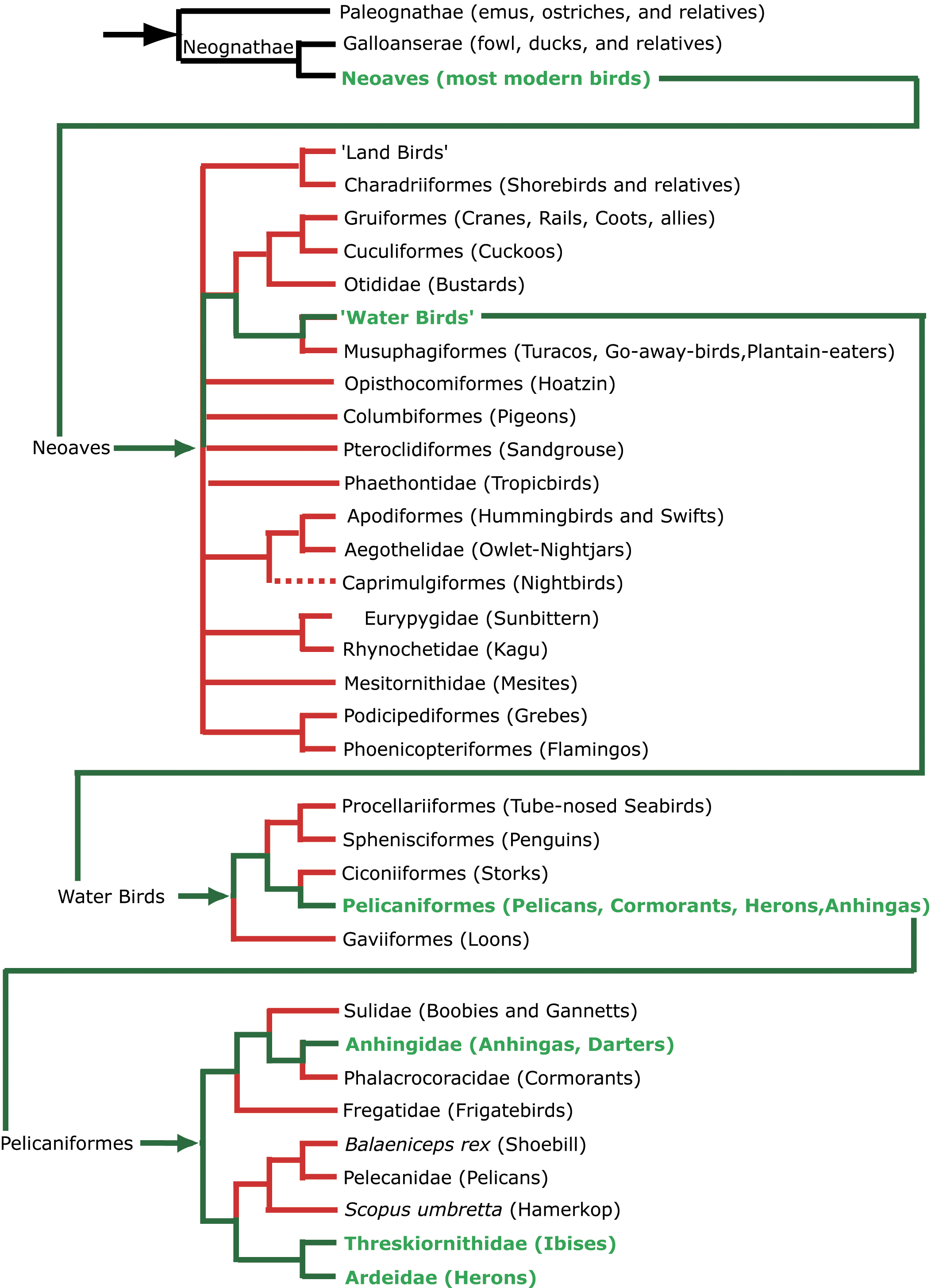- Home
- Rescue
- Art and Literature
- Political Action
- Natural History
- Blog
- Contact
Family Tree of Herons, Egrets, Ibises, and Anhinga
 The diagram
on the left, derived from the Tree of Life web project, traces the lineage of
our rookery birds. Only the branch of each family that leads to our birds is
followed. There may be some surprises to the casual observer. Looking first
at the three main "trunks" of the Class Aves which includes all birds,
we see that familiar waterbirds like ducks, geese, and swans are on a completely
different "trunk" or subclass. They are much more closely related
to chickens than they are to egrets.
The diagram
on the left, derived from the Tree of Life web project, traces the lineage of
our rookery birds. Only the branch of each family that leads to our birds is
followed. There may be some surprises to the casual observer. Looking first
at the three main "trunks" of the Class Aves which includes all birds,
we see that familiar waterbirds like ducks, geese, and swans are on a completely
different "trunk" or subclass. They are much more closely related
to chickens than they are to egrets.
The Neoaves, an incredibly diverse subclass
that contains most bird species, includes an Order that is vaguely called "Water
Birds". This is the branch of the tree that leads to the
herons. Note that, surprisingly, this branch does not include the cranes, which most
people would say resemble herons in their long legs and necks, graceful stride,
and general personality. Nevertheless, the Gruiformes are their own separate, ancient
and fascinating tribe.
Following the branch to the "Water Birds"
Order, we find the next branching point to be the Pelicaniformes
Family. This makes sense as a line to the Heron cousins. Certainly more than Penguins
would.
Finally, we come to the Pelicaniformes,
to which all the birds in the rookery are members in good standing.
Notice that our anhingas
are very closely related to cormorants. You will see that both anhingas and
their cormorant cousins dive for fish, then hold out their soaking wet wings
to dry. This is because, unlike ducks, their feathers are not oiled to repel
water.
Notice that the ibises and herons are also closely related branches. Hence our logo is eminently appropriate for an Heron and Egret Society
You might now be asking yourself, where are the egrets? There is a related very popular
question, what is the difference between egrets and herons, anyway? The answer
to this question is: no difference at all. Some Ardeidae have popular names
that end with "heron" (like little blue heron, Egretta caerulea)
and others end with "egret" (like snowy egret, Egretta thula). These
popular names are quite inconsistent. For example, Audubon himself referred to the snowy egret
as the snowy heron.
 The diagram
on the left, derived from the Tree of Life web project, traces the lineage of
our rookery birds. Only the branch of each family that leads to our birds is
followed. There may be some surprises to the casual observer. Looking first
at the three main "trunks" of the Class Aves which includes all birds,
we see that familiar waterbirds like ducks, geese, and swans are on a completely
different "trunk" or subclass. They are much more closely related
to chickens than they are to egrets.
The diagram
on the left, derived from the Tree of Life web project, traces the lineage of
our rookery birds. Only the branch of each family that leads to our birds is
followed. There may be some surprises to the casual observer. Looking first
at the three main "trunks" of the Class Aves which includes all birds,
we see that familiar waterbirds like ducks, geese, and swans are on a completely
different "trunk" or subclass. They are much more closely related
to chickens than they are to egrets.